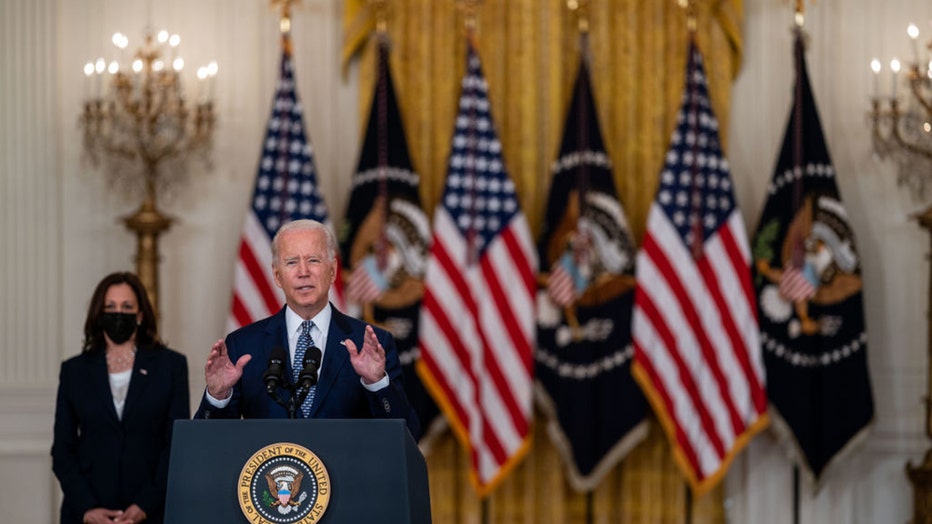Infrastructure bill 2021: What's in the $1 trillion bipartisan plan
WASHINGTON - The Senate has passed a nearly $1 trillion bipartisan plan to rebuild roads and bridges, modernize public works systems and boost broadband internet, among other improvements to the nation's infrastructure.
The White House is projecting that the investments will add, on average, about 2 million jobs per year over the coming decade. Senate Democratic Leader Chuck Schumer said just before the bill passed on Tuesday that the legislation is "a decades-overdue step to revitalize America’s infrastructure and give our workers, our businesses, our economy the tools to succeed in the 21st century."
The Senate will now turn to a second, much larger $3.5 trillion package that would pay for new family, health and education programs, among other liberal priorities. Speaker Nancy Pelosi has said the House will eventually consider both measures together.

FILE - President Joe Biden delivers remarks on the Senate approving H.R. 3684 Infrastructure Investment and Jobs Act, in the East Room of the White House on Tuesday, Aug. 10, 2021 in Washington, DC.
RELATED: ‘Investment in American families’: Biden outlines $3.5T infrastructure spending plan
Here's a breakdown of the bill passed by the Senate:
ROADS AND BRIDGES
The bill would provide $110 billion to repair the nation's aging highways, bridges and roads. According to the White House, 173,000 total miles of America’s highways and major roads and 45,000 bridges are in poor condition. And the almost $40 billion for bridges is the single largest dedicated bridge investment since the construction of the interstate highway system, according to President Joe Biden's administration.
PUBLIC TRANSIT
The $39 billion for public transit in the legislation would expand transportation systems, improve accessibility for people with disabilities and provide dollars to state and local governments to buy zero-emission and low-emission buses. The Department of Transportation estimates that the current repair backlog is more than 24,000 buses, 5,000 rail cars, 200 stations and thousands of miles of track and power systems.
RELATED: Bipartisan Senate passes $1T infrastructure package, sends bill to House
PASSENGER AND FREIGHT RAIL
To reduce Amtrak's maintenance backlog, which has worsened since Superstorm Sandy nine years ago, the bill would provide $66 billion to improve the rail service's 457-mile-long Northeast Corridor as well as other routes. It’s less than the $80 billion Biden — who famously rode Amtrak from Delaware to D.C. during his time in the Senate — originally asked for, but it would be the largest federal investment in passenger rail service since Amtrak was founded 50 years ago.
ELECTRIC VEHICLES
The bill would spend $7.5 billion for electric vehicle charging stations, which the administration says are critical to accelerating the use of electric vehicles to curb climate change. It would also provide $5 billion for the purchase of electric school buses and hybrids, reducing reliance on school buses that run on diesel fuel.
RELATED: Senators on left, right push infrastructure bill closer to final passage
INTERNET ACCESS
The legislation's $65 billion for broadband access would aim to improve internet services for rural areas, low-income families and tribal communities. Most of the money would be made available through grants to states.
MODERNIZING THE ELECTRIC GRID
To protect against the widespread power outages that have become more frequent in recent years, the bill would spend $65 billion to improve the reliability and resiliency of the nation's power grid. It would also boost carbon capture technologies and more environmentally-friendly electricity sources like clean hydrogen.
RELATED: Senate unveils $1T bipartisan infrastructure bill after weekend session
AIRPORTS
The bill would spend $25 billion to improve runways, gates and taxiways at airports and to improve terminals. It would also improve aging infrastructure at air traffic control towers.
WATER AND WASTEWATER
To improve the safety of the nation's drinking water, the legislation would spend $55 billion on water and wastewater infrastructure. The bill would include $15 billion to replace lead pipes and $10 billion to address water contamination from polyfluoroalkyl substances, or PFAS — chemicals that were used in the production of Teflon and have also been used in firefighting foam, water-repellent clothing and many other items.
PAYING FOR IT ALL
The five-year spending package would be paid for by tapping $210 billion in unspent COVID-19 relief aid and $53 billion in unemployment insurance aid some states have halted, along with an array of other smaller pots of money, like petroleum reserve sales and spectrum auctions for 5G services.
___
Associated Press writers Alexandra Jaffe, Kevin Freking and Lisa Mascaro contributed to this report.


